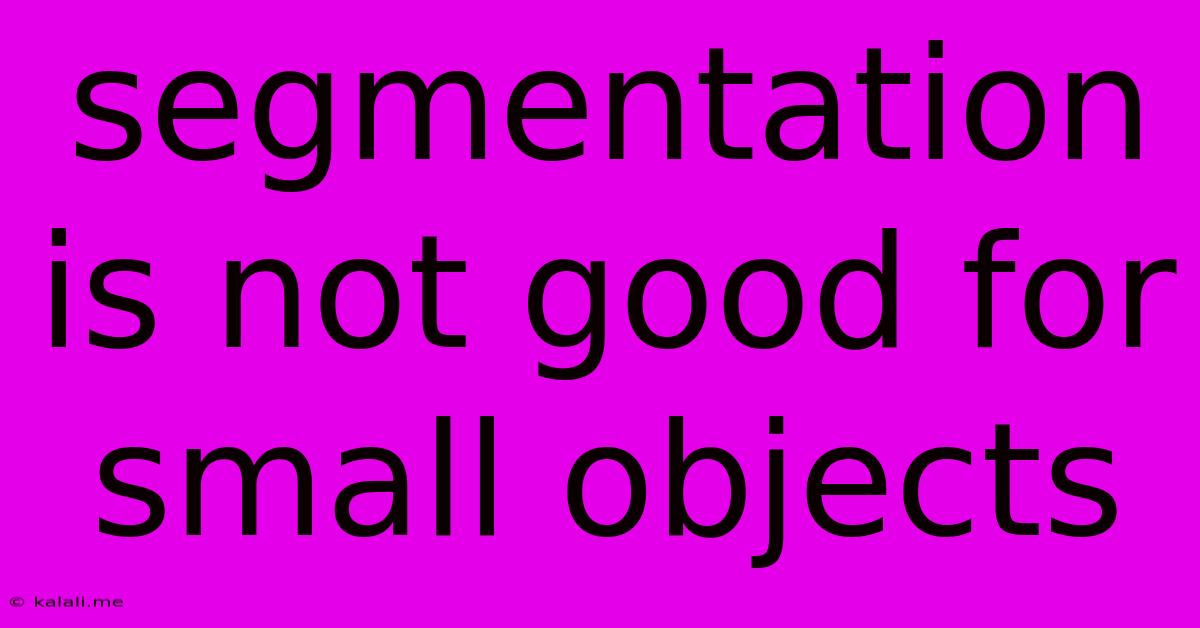Segmentation Is Not Good For Small Objects
Kalali
Jun 05, 2025 · 3 min read

Table of Contents
Segmentation Isn't Always the Answer: Why It Fails for Small Objects
Meta Description: Image segmentation struggles with small objects due to limited pixel information and noise. This article explores the challenges and alternatives for processing tiny objects in images. Learn about better approaches for accurate analysis.
Image segmentation, the process of partitioning an image into meaningful regions, is a powerful tool in computer vision. However, its effectiveness isn't uniform across all scenarios. One significant limitation is its performance when dealing with small objects. While segmentation excels at identifying large, well-defined areas, it often falters when faced with tiny details, leading to inaccurate or incomplete results. This article delves into the reasons behind this limitation and explores alternative methods for analyzing images containing small objects.
The Challenges of Segmenting Small Objects
Several factors contribute to the difficulty of segmenting small objects:
-
Limited Pixel Information: Small objects occupy a limited number of pixels. This scarcity of data makes it challenging for algorithms to accurately distinguish the object's boundaries and features from the background noise. The subtle variations in color and texture that define the object are often lost in the pixel noise.
-
Noise Sensitivity: Image noise, a common occurrence in digital imagery, disproportionately affects small objects. The noise can easily obscure the object's true shape and characteristics, leading to misclassification or incomplete segmentation. This is especially true for low-resolution images where the noise-to-signal ratio is higher.
-
Algorithm Limitations: Many segmentation algorithms rely on detecting edges or regions of consistent color or texture. Small objects often lack the distinctive features required by these algorithms, resulting in their merging with the background or misidentification as part of neighboring objects. Algorithms optimized for large-scale segmentation might simply ignore these minute details.
-
Computational Cost: While not always directly related to the accuracy of segmentation, processing images with numerous small objects can be computationally expensive. The algorithm needs to analyze every pixel, leading to increased processing time and potentially higher resource requirements. This can be a significant drawback in real-time applications.
Alternatives to Segmentation for Small Objects
When dealing with small objects, alternative approaches might yield more accurate and reliable results. Consider these options:
-
Object Detection: Instead of segmenting the entire object, object detection focuses on identifying the presence and location of the object within the image. This approach is less sensitive to noise and requires less detailed information than segmentation, making it suitable for smaller objects. Object detection often uses bounding boxes to locate the objects.
-
Feature Extraction and Classification: Instead of focusing on the visual appearance, extract relevant features from the objects, such as size, shape, texture, or color histograms. Then, use a classifier to categorize these features. This approach is less dependent on the precise segmentation of the object boundaries.
-
Improved Preprocessing: Before applying any segmentation algorithm, enhance the image quality through techniques like noise reduction, sharpening, or contrast enhancement. These preprocessing steps can significantly improve the visibility and definition of small objects, improving the accuracy of subsequent segmentation or other analysis.
-
Super-Resolution Techniques: If the resolution of your images is limiting the ability to discern small objects, consider employing super-resolution techniques to increase the image resolution. This will provide more pixels for each object, making segmentation more accurate.
Conclusion
While image segmentation is a valuable tool, it’s crucial to acknowledge its limitations, particularly when dealing with small objects. The inherent challenges of limited pixel information, noise sensitivity, and algorithm limitations often lead to inaccurate or incomplete results. By understanding these limitations and exploring alternative approaches like object detection, feature extraction, improved preprocessing, and super-resolution, you can achieve more reliable and accurate analysis of images containing small objects, ultimately leading to better results in your applications.
Latest Posts
Latest Posts
-
Mac Delete Folder In Libraray Operation Not Permitted
Jun 06, 2025
-
When Does Rimuru Become A Human
Jun 06, 2025
-
What Does It Mean When Someone Says Beas
Jun 06, 2025
-
Does Super Glue Work On Plastic
Jun 06, 2025
-
Is It Me Neither Or Me Either
Jun 06, 2025
Related Post
Thank you for visiting our website which covers about Segmentation Is Not Good For Small Objects . We hope the information provided has been useful to you. Feel free to contact us if you have any questions or need further assistance. See you next time and don't miss to bookmark.